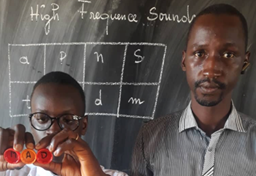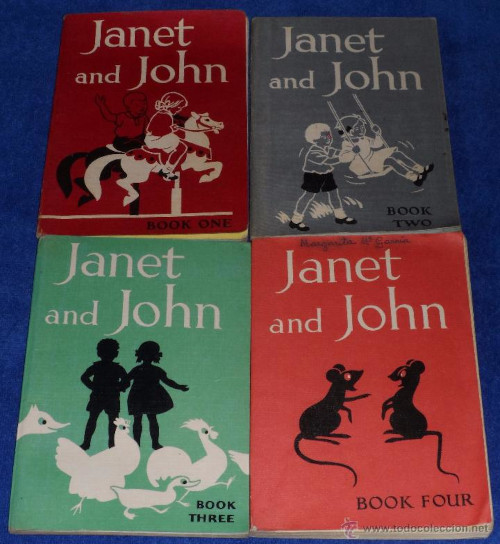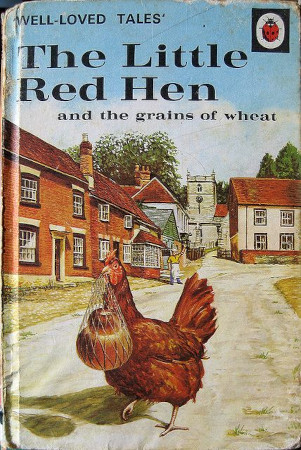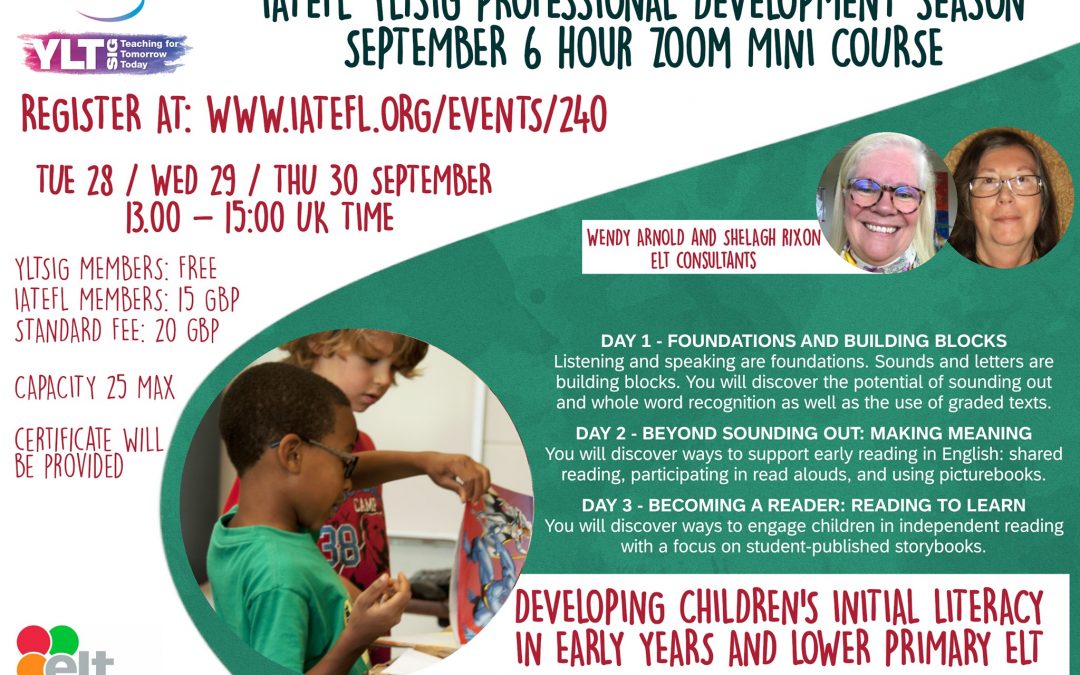The co-facilitators of the IATEFL YLTSIG September 2021 mini course share their personal and professional experiences of early English literacy development.
Wendy’s experiences
While carrying out a long-term action research project on graded readers at a primary school in Hong Kong, I became aware that what some of my colleagues and I regarded as ‘listening’, ‘speaking’, ‘reading’ and ‘writing’ was not entirely in sync. I was concerned about the frequent testing of children’s ability to decode text and read it aloud as ‘speaking’, and ‘reading comprehension’ was a writing assessment with marks deducted for spelling and grammar, and no marks awarded for communicating meaning.
To explore more deeply, I asked the first grade English teacher if I could observe some lessons. I noticed how ‘reading’ was in fact memorisation of the shapes of words via dictation. It was ‘seen’ so the learners knew exactly what was going to appear in the dictation. It was a like memorising a script as actors do, except that an actor doesn’t have to write it down, just say it aloud. At no point were the learners asked the meaning of what they had written.
I asked another colleague if the learners were introduced to the concept of the letters or symbols being sounds in English. This is how the conversation went:
“Oh, you mean the ABC?” the teacher asked.
“Well sort of but more than that, if the learners know that the letters are sounds, they can start to sound out words they don’t know”, I replied.
“Why would you want to do that? the teacher replied, looking confused.
And so my interest in how children with very different reading / writing systems from English learn to become literate in English started. My learners in Hong Kong spoke Cantonese which uses ‘ideographic scripts’ and ‘pictographs’ to separate text from pronunciation. What is fascinating is that the characters in Chinese which represent words do not change much despite there being over 200 dialects. Learning to read in Chinese happens through the writing and memorising the strokes of the characters. English, however, uses a phonetic script, so the letters represent sounds in words. Learning to read in English happens by knowing that the letters represent sounds for the most part, although of course, there are words which cannot be sounded out and need to be memorised.

The longitudinal research also revealed that many primary learners found ‘encoding’ challenging even by grade 6, despite being able to ‘decode’ (read aloud) which was considered ‘speaking’. This explained why their ‘listening’ was not as proficient as expected after six years of English for an hour each day. Therefore, when considering the weighting of language skills in tests, I was disappointed to discover it was 5% each for listening and speaking and 45% each for reading and writing. This might sound like ‘the tail wagging the dog’ as unfortunately in this case, assessment was leading the learning in primary English language education. This is something Shelagh and I hope to address during the September 2021 IATEFL YLTSIG mini course.

Shelagh’s experiences: Old and new understandings
Some of my experiences very much overlap with Wendy’s. I have also had the opportunity to find out how differently people from different teaching and learning contexts see the process of ‘coming to know’ how to read. I hope that, as part of the mini course, we can share some of the contrasts and similarities we have found and invite participants to join in and contribute.
However, being of a certain vintage, I have also a historical perspective, I have lived through different trends and fashions within the UK regarding how children with English as a first language should be taught to read in English. Primary ELT is still trying to make sense of whether L1 methods are relevant to L2 children and if so, how they should be adapted so I think a short description of the famous ‘Reading Wars’ of the last 70 years amongst teachers of reading in English might be useful as part of the course. But I’d like to start with my own reading autobiography – something I think would also be useful for course-members to try – both regarding learning to read in their own languages and in English.
My reading autobiography – Shelagh’s first year or so at school
I came from a family where reading was a major part of life. We can look at the research regarding influence of family during the course, but I am going to skip now to formal instruction that I got in school.
I remember my first days at primary school in the 1950s very well. Teaching us to read was top priority and a combination of approaches was used. Flashcards with names of items in the classroom written on them were shown to us very quickly (‘in a flash’) and then covered up. We competed to put up our hands to name and point at the item or take the word card and attach it to whatever was named on it. We were also taught the most frequent letter-sound values and practised our decoding skills on a dull (but thrilling to us because we could manage it) graded reading book series about The Bell Family. ‘This is Tom Bell. This is Mother Bell. This is Father Bell’ and so on. Learning to write letters and words was taking place at the same time. When we were taught ‘The Magic e’ rule a few weeks in, I was indeed enchanted and went round adding ‘e’ to all sorts of one syllable CVC words (as I now know them), to see what I could make ‘man→mane’, ‘tot→tote’, even nonsense words, and would annoyingly keep asking adults ‘Is this a word?’ about my latest creation.

Stories were read to us every day and we learned songs and rhymes. We read aloud one-to-one with the teacher, at least once a week, and in busy time, played dominoes-style and card-matching games with words and pictures. Once we were thought to be ‘self-propelled’ we were allowed to read our way at our own pace through a reading book series. This was more entertaining than the chronicles of The Bell Family. I still have the postcard of kittens I was given as a reward by the headteacher for reading The Little Red Hen.

Looking back, I now know that a balanced combination of two named methods ‘Look and Say’ (learning whole words by their overall appearance) and Phonics (learning the sound values that letters can have and using this knowledge to ‘sound out’ words) was being used to start us off as readers.
Why the autobiography? Partly, because for each item in the story above, I can now find research literature that comments on how this sort of activity contributes to developing a child who not only can read but does read. I also understand now how powerful such memories are in shaping what future teachers believe to be the right thing to do. In my case, as a five-year old I saw the point of the balance of methods used for my first steps in reading and I see the point now. Given that English has so many ‘tricky’ words on which Phonics does not work well we needed whole-word recognition skills in addition to Phonics. Today, the English-speaking world seems to have gone over to Phonics-alone, which, given my experiences, I find hard to accept!
During the mini course, we will ask the course participants if they would like to write and share ‘early reading autobiographies’ and see if they can pick out influences that are still with them today.

